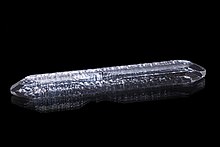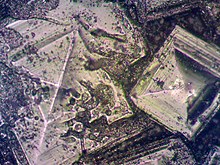Single crystal
This article needs additional citations for verification. (February 2010) |
In
Because
The opposite of a single crystal is an
Production methods
Although current methods are extremely sophisticated with modern technology, the origins of crystal growth can be traced back to salt purification by crystallization in 2500 BCE. A more advanced method using an aqueous solution was started in 1600 CE while the melt and vapor methods began around 1850 CE.[7]

Basic crystal growth methods can be separated into four categories based on what they are artificially grown from: melt, solid, vapor, and solution.

In the case of metal single crystals, fabrication techniques also include epitaxy and abnormal grain growth in solids.[11] Epitaxy is used to deposit very thin (micrometer to nanometer scale) layers of the same or different materials on the surface of an existing single crystal.[12] Applications of this technique lie in the areas of semiconductor production, with potential uses in other nanotechnological fields and catalysis.[13]
It is extremely difficult to grow single crystals of the polymers. It is mainly because that the polymer chains are of different length and due to the various entropy reasons. However, topochemical reactions are one of the easy methods to get single crystals of the polymer.[1]
Applications
Semiconductor industry
One of the most used single crystals is that of Silicon in the semiconductor industry. The four main production methods for semiconductor single crystals are from metallic solutions:


Other inorganic semiconducting single crystals include GaAs, GaP, GaSb, Ge, InAs, InP, InSb, CdS, CdSe, CdTe, ZnS, ZnSe, and ZnTe. Most of these can also be tuned with various doping for desired properties.[19] Single-crystal graphene is also highly desired for applications in electronics and optoelectronics with its large carrier mobility and high thermal conductivity, and remains a topic of fervent research.[20] One of the main challenges has been growing uniform single crystals of bilayer or multilayer graphene over large areas; epitaxial growth and the new CVD (mentioned above) are among the new promising methods under investigation.[21]
Organic semiconducting single crystals are different from the inorganic crystals. The weak intermolecular bonds mean lower melting temperatures, and higher vapor pressures and greater solubility.[22] For single crystals to grow, the purity of the material is crucial and the production of organic materials usually require many steps to reach the necessary purity.[23] Extensive research is being done to look for materials that are thermally stable with high charge-carrier mobility. Past discoveries include naphthalene, tetracene, and 9,10-diphenylanthacene (DPA).[24] Triphenylamine derivatives have shown promise, and recently in 2021, the single-crystal structure of α-phenyl-4′-(diphenylamino)stilbene (TPA) grown using the solution method exhibited even greater potential for semiconductor use with its anisotropic hole transport property.[25]
Optical application
This section needs expansion. You can help by adding to it. (April 2009) |
Single crystals have unique physical properties due to being a single grain with molecules in a strict order and no grain boundaries.[2] This includes optical properties, and single crystals of silicon is also used as optical windows because of its transparency at specific infrared (IR) wavelengths, making it very useful for some instruments.[5]
Sapphires: Also known as the alpha phase of aluminum oxide (Al2O3) to scientists, sapphire single crystals are widely used in hi-tech engineering. It can be grown from gaseous, solid, or solution phases.[10] The diameter of the crystals resulting from the growth method are important when considering electronic uses after. They are used for lasers and nonlinear optics. Some notable uses are as in the window of a biometric fingerprint reader, optical disks for long-term data storage, and X-ray interferometer.[2]
Indium Phosphide: These single crystals are particularly appropriate for combining optoelectronics with high-speed electronics in the form of optical fiber with its large-diameter substrates.[26] Other photonic devices include lasers, photodetectors, avalanche photo diodes, optical modulators and amplifiers, signal processing, and both optoelectronic and photonic integrated circuits.[27]

Germanium: This was the material in the first transistor invented by Bardeen, Brattain, and Shockley in 1947. It is used in some gamma-ray detectors and infrared optics.[28] Now it has become the focus of ultrafast electronic devices for its intrinsic carrier mobility.[27]
Arsenide: Arsenide III can be combined with various elements such as B, Al, Ga, and In, with the GaAs compound being in high demand for wafers.[27]
Cadmium Telluride: CdTe crystals have several applications as substrates for IR imaging, electrooptic devices, and solar cells.[29] By alloying CdTe and ZnTe together room-temperature X-ray and gamma-ray detectors can be made.[27]
Electrical conductors
Metals can surprisingly be produced in single-crystal form and provide a means to understand the ultimate performance of metallic conductors. It is vital for understanding the basic science such as catalytic chemistry, surface physics, electrons, and monochromators.[4] Production of metallic single crystals have the highest quality requirements and are grown, or pulled, in the form of rods.[30] Certain companies can produce specific geometries, grooves, holes, and reference faces along with varying diameters.[19]
Of all the metallic elements, silver and copper have the best
The conductivity of commercial conductors is often expressed relative to the
As anticipated, single-crystal copper did prove to have better conductivity than polycrystalline copper.[32]
| Material | ρ (μΩ∙cm) | IACS[34] |
|---|---|---|
| Single-crystal Ag, doped with 3 mol% Cu | 1.35 | 127% |
| Single-crystal Cu, further processed[35] | 1.472 | 117.1% |
| Single-crystal Ag | 1.49 | 115.4% |
| Single-crystal Cu | 1.52 | 113.4% |
| High-purity Ag wire (polycrystalline) | 1.59 | 108% |
| High-purity Cu wire (polycrystalline) | 1.67 | ˃ 103% |
However, the single-crystal copper not only became a better conductor than high purity polycrystalline silver, but with prescribed heat and pressure treatment could surpass even single-crystal silver. Although impurities are usually bad for conductivity, a silver single crystal with a small amount of copper substitutions proved to be the best.
As of 2009, no single-crystal copper is manufactured on a large scale industrially, but methods of producing very large individual crystal sizes for copper conductors are exploited for high performance electrical applications. These can be considered meta-single crystals with only a few crystals per meter of length.

Single-crystal turbine blades
Another application of single-crystal solids is in materials science in the production of high strength materials with low thermal
In research
Single crystals are essential in research especially
As such, numerous new materials are being studied in their single-crystal form. The young field of metal-organic-frameworks (MOFs) is one of many which qualify to have single crystals. In January 2021 Dr. Dong and Dr. Feng demonstrated how polycyclic aromatic ligands can be optimized to produce large 2D MOF single crystals of sizes up to 200 μm. This could mean scientists can fabricate single-crystal devices and determine intrinsic electrical conductivity and charge transport mechanism.[43]
The field of photodriven transformation can also be involved with single crystals with something called single-crystal-to-single-crystal (SCSC) transformations. These provide direct observation of molecular movement and understanding of mechanistic details.[44] This photoswitching behavior has also been observed in cutting-edge research on intrinsically non-photo-responsive mononuclear lanthanide single-molecule-magnets (SMM).[45]
See also
- Engineering aspects of crystallisation
- Fractional crystallization
- Laser-heated pedestal growth
- Micro-pulling-down
- Recrystallization
- Seed crystal
References
- ^ a b RIWD. "Reade Advanced Materials – Single Crystals". www.reade.com. Retrieved 2021-02-28.
- ^ OCLC 1055046791.[page needed]
- ^ "Single Crystals – Alfa Chemistry". www.alfa-chemistry.com. Retrieved 2021-02-28.
- ^ a b "Pure Element Single Crystals – Alfa Chemistry". www.alfa-chemistry.com. Retrieved 2021-02-28.
- ^ a b "4.1: Introduction". Engineering LibreTexts. 2019-02-08. Retrieved 2021-02-28.
- ^ a b "DoITPoMS – TLP Library Atomic Scale Structure of Materials". www.doitpoms.ac.uk. Retrieved 2021-02-28.
- ^ S2CID 240461586.
- S2CID 240461586.
- ISBN 9780444633033.
- ^ a b Zalozhny, Eugene (Jul 13th, 2015). "Monocrystal enables high-volume LED and optical applications with 300-kg KY sapphire crystals". LED's Magazine. Retrieved February 27, 2021.
- S2CID 208729868.
- PMID 29311332.
- ^ "Single Crystal Substrates – Alfa Chemistry". www.alfa-chemistry.com. Retrieved 2021-03-11.
- ISBN 978-0-444-52232-0, retrieved 2021-03-11
- S2CID 139380571, retrieved 2021-03-11
- ^ "CZ-Si Wafers – Nanografi". nanografi.com. Retrieved 2021-02-28.
- ISBN 978-1-4377-7859-5, retrieved 2021-03-11
- ISBN 9780444633033.
- ^ a b "Semiconductor Single Crystals". Princeton Scientific. Retrieved 2021-02-08.
- PMID 24297886.
- S2CID 229501087.
- .
- S2CID 213570529.
- S2CID 97631495.
- .
- ^ "Indium Phosphide PICs". 100G Optical Components, Coherent, PIC, DWDM. Retrieved 2021-03-12.
- ^ OCLC 1054250691.[page needed]
- )
- .
- ^ "Scientists blow hot and cold to produce single-crystal metal". Materials Today. Retrieved 2021-03-12.
- ^ "TIBTECH innovations: Metal properties comparison: electric conductivity, thermal conductivity, density, melting temperature". www.tibtech.com. Retrieved 2021-03-12.
- .
- PMID 24965478.
- ^ "The International Annealed Copper Standard". Nondestructive Testing Resource Center. The Collaboration for NDT Education, Iowa State University. n.d. Retrieved November 14, 2016.
- .
- Rolls-Royce plc, 2003. Retrieved: 21 July 2012.
- ^ Crown jewels – These crystals are the gems of turbine efficiency Archived 2010-03-25 at the Wayback Machine Article on single-crystal turbine blades memagazine.com
- ^ "Each Blade a Single Crystal". American Scientist. 2017-02-06. Retrieved 2021-02-08.
- ^ "Silver Single Crystal". Materials Hub. Retrieved 2021-03-12.
- .
- ^ "6.2: Low Energy Electron Diffraction (LEED)". Chemistry LibreTexts. 2015-02-11. Retrieved 2021-03-12.
- S2CID 220793188.
- S2CID 231745364.
- .
- S2CID 209490756.

